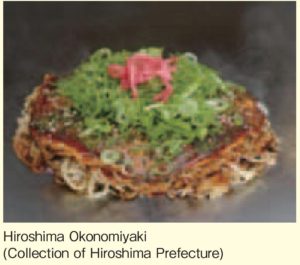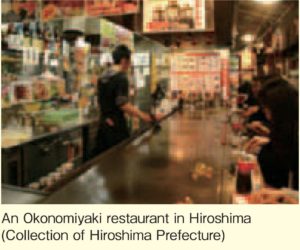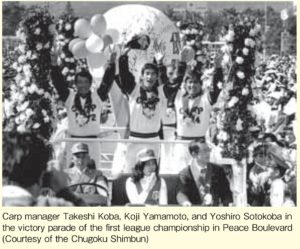column 1 Okonomiyaki and the Hiroshima Toyo CARP
Introduction
On October 15, 1975, the “Okonomimura (Okonomiyaki Village)” (in Shintenchi, Hiroshima) overflowed with customers. The crowd earned bragging rights that day as they cheered the first league championship of its local baseball team, the Hiroshima Carp. The party was televised throughout Japan, and it is said that that was the time when Hiroshima’s soul food, Okonomiyaki gained national recognition.
1. Special layering technique
Hiroshima’s unique Okonomiyaki is known for its carefully constructed layers, created using a creative cooking technique utilizing a spatula and a cast-iron grill. Unlike Osaka-style Okonomiyaki, which simply mixes all the ingredients together, Hiroshima Okonomiyaki is made up of layers of cabbage, small pieces of deep-fried dough, bean sprouts, deboned pork ribs, a crepe-like dough made from wheat flour and more. After cooking a while, the mixture is flipped over and Chinese noodles, that have been stir-fried separately, are added to it. Everything is layered on top of the thin round crepe and is flipped over. It is served with a local specialty sauce and green seaweed flakes.
Hiroshima Okonomiyaki is made up of layers of cabbage, small pieces of deep-fried dough, bean sprouts, deboned pork ribs, a crepe-like dough made from wheat flour and more. After cooking a while, the mixture is flipped over and Chinese noodles, that have been stir-fried separately, are added to it. Everything is layered on top of the thin round crepe and is flipped over. It is served with a local specialty sauce and green seaweed flakes.
The evolution of this Hiroshima-style Okonomiyaki coincides with the city’s reconstruction process. Shortly after the end of war, stalls selling simple dishes cooked on cast iron appeared on the streets near the hypocenter, barely escaping the devastating fires and destruction of the atomic bombing. Many of the stands were owned by women who also cooked the food. This may have been because so many women had been widowed in either the war or the atomic bombing. They started selling a dish referred to as Issen Yoshoku which had been cooked and sold at the mom-and-pop candy stores before the war.  They served cheap simple dish of a wheat-flour mixed with water to make a crepe, baked on a cast-iron pan with green onion and shrimp, folded and eaten with soy sauce. Amid the food shortages in the postwar period, hungry children brought leftover vegetables or cold cooked rice from their home to Issen Yoshoku stands to have them wrapped in crepes to sate their hunger. These stands were operated like second kitchens in downtown areas and came to represent the spirit of community support among A-bomb survivors. Through trial and error, the ingredients were improved, as they were paired with the crepe, and gradually evolved into the Hiroshima-style Okonomiyaki of today.
They served cheap simple dish of a wheat-flour mixed with water to make a crepe, baked on a cast-iron pan with green onion and shrimp, folded and eaten with soy sauce. Amid the food shortages in the postwar period, hungry children brought leftover vegetables or cold cooked rice from their home to Issen Yoshoku stands to have them wrapped in crepes to sate their hunger. These stands were operated like second kitchens in downtown areas and came to represent the spirit of community support among A-bomb survivors. Through trial and error, the ingredients were improved, as they were paired with the crepe, and gradually evolved into the Hiroshima-style Okonomiyaki of today.
Reconstruction in the central part of the city progressed, and stalls selling Okonomiyaki started appearing in the Shintenchi district around 1950. These stalls modified the Okonomiyaki created in the downtown stands by adding Chinese noodles and eggs (this increased the calories and richness to satisfy adults). In this way, the classic Hiroshima-style Okonomiyaki made with noodles, pork, and egg was made. At around the same time, a unique thick sauce that went fantastically with the Okonomiyaki was created. The Okonomiyaki stalls became a kind of community space for conversation and relaxation among the Hiroshima citizens after the atomic bombing.
In 1969, some of the Okonomiyaki stalls gathered in the two-story steel-frame building in Shintenchi to form the “Okonomimura (Okonomiyaki Village),” after which more and more of them continued to open. Today, there are nearly 900 Okonomiyaki restaurants in Hiroshima City (about 1,700 in Hiroshima Prefecture), attracting a vast number of travelers and students who visit Hiroshima on school field trips.
2. Brought up by the people of Hiroshima
Hiroshima’s professional baseball team, the Hiroshima Carp was founded in 1949. At that time, ruins of the atomic bombing remained everywhere in Hiroshima City. When Japan’s professional baseball league split into two in 1950, the Hiroshima Carp took advantage of the new opportunity to join the league. The addition of the Hiroshima Carp was approved, and its official formation was celebrated under the gaze of approximately 20,000 fans on January 15, 1950. Their first game was held on March 10. Among other reasons, the name “carp” was chosen because carp (a fish symbolic of success in life) were fished in the Ota River, and because Hiroshima Castle is nicknamed the Rijo (“Carp” Castle). Unlike other baseball teams, the Carp did not have a parent company. The Hiroshima Carp was born through the joint investments of the Hiroshima Prefectural Government, the City of Hiroshima, other local governments, companies and individuals in Hiroshima Prefecture. As the representative baseball team of the people of Hiroshima Prefecture, the team bears the name “Hiroshima.” The Carp was established to encourage the people of Hiroshima City who were still suffering from the effects of the atomic bombing. In the very beginning of the history of the Carp, the team had players that were burdened by the shadows of war. Takashi Harada was experienced the atomic bombing while in Minami-machi, and Kenshi Zenimura, a Japanese-American from Hawaii, was sent to a Japanese-American internment camp during the World War II. At the beginning, though the team went through seriousfinancial difficulties. There were on-going delays in salary payments to players and the team suffered from a shortage of funds for traveling to away games. They even lacked the funds to buy uniforms for the players. The team’s first manager, Shuichi Ishimoto, had to make every effort to raise funds. The team was faced with the crises of disbanded time and again. As can be expected, the people of Hiroshima started fan clubs at work to support their local team. Money was collected in Japanese sake casks (as Hiroshima is home to many sake brewers) and placed in front of the baseball stadium to save the team from distress. Reminiscing about those days, manager Ishimoto later recalled, “the citizens of Hiroshima, who suffered from the atomic bombing, found in the Carp something they could believe in” (The Yomiuri Shimbun, Oct. 16, 1975). In this way, fans called the Carp “our team” and had supported it so feverishly. The Hiroshima Municipal Baseball Stadium with Hiroshima’s first night game facilities was constructed in July 1957 at a location facing the A-bomb Dome. The first night game was held on July 24 (and many years later the stadium was demolished due to age). Now, the home of the team is the newly-built Hiroshima Municipal Baseball Stadium, the “MAZDA Zoom-Zoom Stadium Hiroshima,” (also known as “Mazda Stadium,”) constructed in the vicinity of Hiroshima Station. The Hiroshima Carp came into being immediately after the atomic bombing and made progress that seemed to coincide with Hiroshima’s reconstruction. The team is representative of sports in Hiroshima and has blazed a trail for community-based professional sports.
The Carp was established to encourage the people of Hiroshima City who were still suffering from the effects of the atomic bombing. In the very beginning of the history of the Carp, the team had players that were burdened by the shadows of war. Takashi Harada was experienced the atomic bombing while in Minami-machi, and Kenshi Zenimura, a Japanese-American from Hawaii, was sent to a Japanese-American internment camp during the World War II. At the beginning, though the team went through seriousfinancial difficulties. There were on-going delays in salary payments to players and the team suffered from a shortage of funds for traveling to away games. They even lacked the funds to buy uniforms for the players. The team’s first manager, Shuichi Ishimoto, had to make every effort to raise funds. The team was faced with the crises of disbanded time and again. As can be expected, the people of Hiroshima started fan clubs at work to support their local team. Money was collected in Japanese sake casks (as Hiroshima is home to many sake brewers) and placed in front of the baseball stadium to save the team from distress. Reminiscing about those days, manager Ishimoto later recalled, “the citizens of Hiroshima, who suffered from the atomic bombing, found in the Carp something they could believe in” (The Yomiuri Shimbun, Oct. 16, 1975). In this way, fans called the Carp “our team” and had supported it so feverishly. The Hiroshima Municipal Baseball Stadium with Hiroshima’s first night game facilities was constructed in July 1957 at a location facing the A-bomb Dome. The first night game was held on July 24 (and many years later the stadium was demolished due to age). Now, the home of the team is the newly-built Hiroshima Municipal Baseball Stadium, the “MAZDA Zoom-Zoom Stadium Hiroshima,” (also known as “Mazda Stadium,”) constructed in the vicinity of Hiroshima Station. The Hiroshima Carp came into being immediately after the atomic bombing and made progress that seemed to coincide with Hiroshima’s reconstruction. The team is representative of sports in Hiroshima and has blazed a trail for community-based professional sports.
Sadly, for years the Carp continued losing games and were considered “a burden on the league,” finishing dead last. In October 1974, Joe Lutz, who had coaching experience in the Major Leagues, became their manager—the first American manager of a Japanese professional baseball. He changed the color of the caps and helmets to red, which he called a “fighting color.” As drastic trading of players and position changes had much success, the Carp made a splash in the pennant race with their red helmets the following year. On October 15, they won the league championship under their new manager Takeshi Koba, who took over the team after Lutz. The Hiroshima Carp won the long-cherished pennant (26 years after they were founded) and it was a time when their playing style, built upon for long time, blossomed.
Conclusion
The Hiroshima Carp (officially named the “Hiroshima Toyo Carp”), Okonomiyaki, and the World Heritage Sites; the A-bomb Dome and Miyajima (Itsukushima Shrine) are just the beginning of Hiroshima’s attractions. In terms of sports and culture, together with the Hiroshima Carp, the Sanfrecce Hiroshima Football Club and the Hiroshima Symphony Orchestra with over 50-years of history form the three well-known top professional organizations. The other flavors of Hiroshima cuisine are also rich in variety, and include oysters, small sardines, Momiji manju (maple leaf-shaped steamed bun with bean jam), lemon (Hiroshima Prefecture ranks first in the production of lemons in Japan), Japanese sake, and more. The city’s well-developed transportation network makes travel comfortable for visitors. There are the streetcars that resumed service immediately after the bombing, plus buses, railways, and ships. After overcoming numerous challenges and enormous hardships through its tireless efforts, Hiroshima, an A-bombed city, has been reborn as a city of international peace.
(Hitoshi Nagai)
Inquiries about this page
Hiroshima Prefectural Office
Street address:10-52, Motomachi, Naka-ku, Hiroshima-shi, Hiroshima-ken, 730-8511
Tel:+81-(0)82-228-2111





